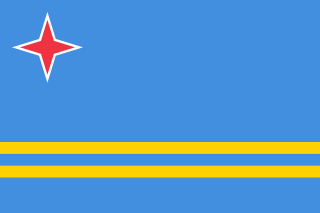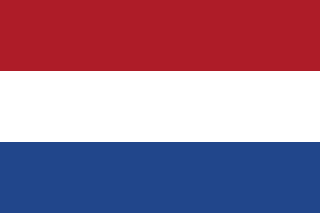Related Research Articles

Aruba, officially the Country of Aruba, is a constituent country within the Kingdom of the Netherlands, in the southern Caribbean Sea 29 kilometres (18 mi) north of the Venezuelan peninsula of Paraguaná and 80 kilometres (50 mi) northwest of Curaçao. In 1986, it became a constituent country within the Kingdom of the Netherlands and acquired the formal name the Country of Aruba.

The Netherlands Antilles, also known as the Dutch Antilles, was a constituent Caribbean country of the Kingdom of the Netherlands consisting of the islands of Saba, Sint Eustatius, and Sint Maarten in the Lesser Antilles, and Aruba, Curaçao, and Bonaire in the Leeward Antilles. The country came into being in 1954 as the autonomous successor of the Dutch colony of Curaçao and Dependencies, and it was dissolved in 2010, when like Aruba in 1986, Sint Maarten and Curaçao gained status of constituent countries within the Kingdom of the Netherlands, and Saba, Sint Eustatius, and Bonaire gained status of special municipality of Netherlands as the Caribbean Netherlands. The neighboring Dutch colony of Surinam in continental South America, did not become part of the Netherlands Antilles but became a separate autonomous country in 1954. All the territories that belonged to the Netherlands Antilles remain part of the kingdom today, although the legal status of each differs. As a group they are still commonly called the Dutch Caribbean, regardless of their legal status. People from this former territory continue to be called Antilleans in the Netherlands.

This is a demography of the population of Aruba including population density, ethnicity, nationality language use, education level, health of the populace, economic status, religious affiliations and other aspects of the population.
The music of the Lesser Antilles encompasses the music of this chain of small islands making up the eastern and southern portion of the West Indies. Lesser Antillean music is part of the broader category of Caribbean music; much of the folk and popular music is also a part of the Afro-American musical complex, being a mixture of African, European and indigenous American elements. The Lesser Antilles' musical cultures are largely based on the music of African slaves brought by European traders and colonizers. The African musical elements are a hybrid of instruments and styles from numerous West African tribes, while the European slaveholders added their own musics into the mix, as did immigrants from India. In many ways, the Lesser Antilles can be musically divided based on which nation colonized them.

Oranjestad, the capital and most populous of Aruba's eight regions, is located on the southwestern coast of the island. In Papiamento, the local language, Oranjestad is commonly referred to as "Playa" by the locals.

ALM Antillean Airlines, and later Air ALM, was the main airline of the Netherlands Antilles between its foundation in 1964 and its shut-down in 2001, operating out of Aruba, Bonaire, and Curaçao. It was based at Hato International Airport.
Afro-Caribbean or African Caribbeanpeople are Caribbean people who trace their full or partial ancestry to Africa. The majority of the modern Afro-Caribbean people descend from the Africans taken as slaves to colonial Caribbean via the trans-Atlantic slave trade between the 15th and 19th centuries to work primarily on various sugar plantations and in domestic households. Other names for the ethnic group include Black Caribbean, Afro- or Black West Indian, or Afro- or Black Antillean. The term West Indian Creole has also been used to refer to Afro-Caribbean people, as well as other ethnic and racial groups in the region, though there remains debate about its use to refer to Afro-Caribbean people specifically. The term Afro-Caribbean was not coined by Caribbean people themselves but was first used by European Americans in the late 1960s.
The United States has a racially and ethnically diverse population. At the federal level, race and ethnicity have been categorized separately. The most recent United States census recognized five racial categories, as well as people who belong to two or more of the racial categories. The United States also recognizes the broader notion of ethnicity. The 2000 census and 2010 American Community Survey inquired about the "ancestry" of residents, while the 2020 census allowed people to enter their "origins". The Census Bureau also classified respondents as either Hispanic or Latino, identifying as an ethnicity, which comprises the minority group in the nation.
The demographics of Brooklyn reveal a very diverse borough of New York City and a melting pot for many cultures, like the city itself. Since 2010, the population of Brooklyn was estimated by the Census Bureau to have increased 3.5% to 2,592,149 as of 2013, representing 30.8% of New York City's population, 33.5% of Long Island's population, and 13.2% of New York State's population. If the boroughs of New York City were separate cities, Brooklyn would be the third largest city in the United States after Los Angeles and Chicago.

Caribbean Americans or West Indian Americans are Americans who trace their ancestry to the Caribbean. Caribbean Americans are a multi-ethnic and multi-racial group that trace their ancestry further in time to Europe, Africa, Asia, and the Indigenous peoples of the Americas. As of 2016, about 13 million — about 4% of the total U.S. population — have Caribbean ancestry.

Since its founding in 1625 by Dutch traders as New Amsterdam, New York City has been a major destination for immigrants of many nationalities who have formed ethnic enclaves, neighborhoods dominated by one ethnicity. Freed African American slaves also moved to New York City in the Great Migration and the later Second Great Migration and formed ethnic enclaves. These neighborhoods are set apart from the main city by differences such as food, goods for sale, or even language. Ethnic enclaves provide inhabitants security in work and social opportunities, but limit economic opportunities, do not encourage the development of English speaking, and keep immigrants in their own culture.
Asian people are the people of the continent of Asia. The term may also refer to their descendants.
BarbadianAmericans are Americans of full or partial Barbadian heritage. The 2000 Census recorded 53,785 US residents born on the Caribbean island 52,170 of whom were born to non-American parents and 54,509 people who described their ethnicity as Barbadian. The 2010 US Census estimation report stated more than 62,000 Barbadian Americans are resident in the United States, most of whom are in the area of New York City extending from Rhode Island to Delaware. In past years, some also moved to the areas of Chicago, Illinois, and Boston, Massachusetts.

The following is an alphabetical list of topics related to the former nation of the Netherlands Antilles.
Guyanese Americans are American people with Guyanese ancestry or immigrants who were born in Guyana. Guyana is home to people of many different national, ethnic and religious origins. As of 2019, there are 231,649 Guyanese Americans currently living in the United States. The majority of Guyanese live in New York City – some 140,000 – making them the fifth-largest foreign-born population in the city.

The languages of the Caribbean reflect the region's diverse history and culture. There are six official languages spoken in the Caribbean:

The Dutch Caribbean are the New World territories, colonies, and countries of the Dutch Empire and the Kingdom of the Netherlands located in the Caribbean Sea, mainly the northern and southwestern regions of the Lesser Antilles archipelago.
Afro-Arubans are Arubans who have predominantly African ancestry. Afro-Arubans are a minority ethnic group in Aruba and represent 15% of Aruba's population. Like other Arubans, Afro-Arubans speak Papiamento, a Portuguese-based creole language commonly spoken on the ABC islands, as well as Dutch, Spanish, English and other languages. Papiamento dates back at least 300 years and is pre-dominantly based on Afro-Portuguese linguistic structures combined with vocabulary and influences from Spanish, West African languages, Dutch and Amerindian languages.

Panamanians are people identified with Panama, a country in Central America, and with residential, legal, historical, or cultural connections with North America. For most Panamanians, several or all of these connections exist and are collectively the source of their Panamanian identity. Panama is a multilingual and multicultural society, home to people of many different ethnicities and religions. Therefore, many Panamanians do not equate their nationality with ethnicity, but with citizenship and allegiance to Panama. The overwhelming majority of Panamanians are the product of varying degrees of admixture between European ethnic groups with native Amerindians and Black Africans.
The city of Baltimore, Maryland includes a large and growing Caribbean-American population. The Caribbean-American community is centered in West Baltimore. The largest non-Hispanic Caribbean populations in Baltimore are Jamaicans, Trinidadians and Tobagonians, and Haitians. Baltimore also has significant Hispanic populations from the Spanish West Indies, particularly Puerto Ricans, Dominicans, and Cubans. Northwest Baltimore is the center of the West Indian population of Baltimore, while Caribbean Hispanics in the city tend to live among other Latinos in neighborhoods such as Greektown, Upper Fell's Point, and Highlandtown. Jamaicans and Trinidadians are the first and second largest West Indian groups in the city, respectively. The neighborhoods of Park Heights and Pimlico in northwest Baltimore are home to large West Indian populations, particularly Jamaican-Americans.
References
- ↑ "Total ancestry categories tallied for people with one or more ancestry categories reported 2010 American Community Survey 1-Year Estimates". United States Census Bureau. Archived from the original on 18 January 2015. Retrieved 30 November 2012.
- ↑ "Archived copy". Archived from the original on 2018-04-12. Retrieved 2018-03-26.
{{cite web}}: CS1 maint: archived copy as title (link) - ↑ "Archived copy". Archived from the original on 2015-12-01. Retrieved 2020-03-20.
{{cite web}}: CS1 maint: archived copy as title (link) - ↑ Ph.D, Reed Ueda (September 21, 2017). America's Changing Neighborhoods: An Exploration of Diversity through Places [3 volumes]. ABC-CLIO. ISBN 9781440828652 – via Google Books.
- ↑ "Table 1. First, Second, and Total Responses to the Ancestry Question by Detailed Ancestry Code: 2000". U.S. Census Bureau. Retrieved 2013-10-27.
- ↑ "Most Unusual Ancestry by State – Page 10 – 24/7 Wall St".
- ↑ Cooper, Michael (24 December 1995). "NEIGHBORHOOD REPORT: FLATBUSH;Dutch Christmas Via the Caribbean". The New York Times.
- ↑ "Languages of New York City Map".
- ↑ "Immigrant and Emigrant Populations by Country of Origin and Destination". 10 February 2014.